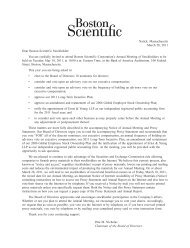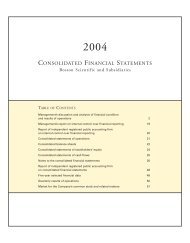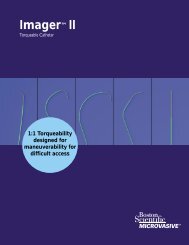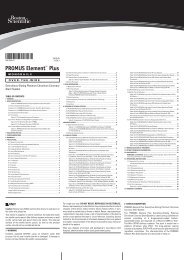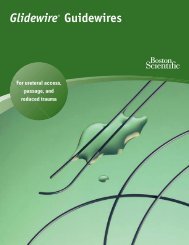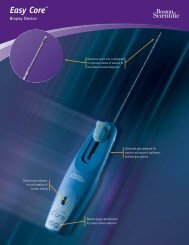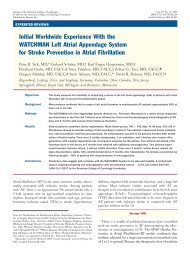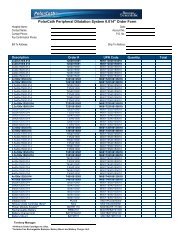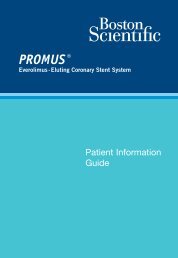Physician Reimbursement Primer for Cardiac ... - Boston Scientific
Physician Reimbursement Primer for Cardiac ... - Boston Scientific
Physician Reimbursement Primer for Cardiac ... - Boston Scientific
Create successful ePaper yourself
Turn your PDF publications into a flip-book with our unique Google optimized e-Paper software.
Overview of Coding and Payment Systems<br />
<strong>for</strong> an encounter. Payment may be reduced <strong>for</strong> certain procedures per<strong>for</strong>med in<br />
combination with others.<br />
As an example, suppose a hospital outpatient department reports CPT code 33208:<br />
33208 Dual-chamber pacemaker insertion with RA and RV lead insertion<br />
Medicare will classify this procedure under APC 0655, Insertion/Replacement/Conversion<br />
of a Permanent Dual Chamber Pacemaker, <strong>for</strong> which the 2009 national base payment<br />
rate is $ $9,512.21. Medicare will adjust this amount by a local wage index, and<br />
reimburse the hospital.<br />
Each year, CMS publishes a proposed and then final rule in the Federal Register to<br />
update the outpatient prospective payment system (OPPS). These annual revisions<br />
commonly include updating the payment rates and adding or deleting codes, among<br />
other changes.<br />
Payment <strong>for</strong> Ambulatory Surgical Centers<br />
The Medicare OPPS relative payment weight and rate in<strong>for</strong>mation<br />
is used to determine<br />
payment rates <strong>for</strong> procedures per<strong>for</strong>med in ambulatory surgical centers (ASCs). These<br />
are health care facilities that specialize in providing surgery and certain pain<br />
management and diagnostic services in an outpatient setting. The 2008 ASC payment<br />
update provided an increase in coverage of many CRM device-related procedures that<br />
have never been per<strong>for</strong>med in this setting. Typically ASC payments <strong>for</strong> CRM services are<br />
85 percent to 95 percent of outpatient payments.<br />
Inpatient Procedure and Diagnosis Coding<br />
In-Patient Admission General Rules<br />
For a procedure to be per<strong>for</strong>med in the inpatient setting,<br />
the physician must issue clear<br />
admission orders (“admit to hospital” versus “place in observation”), and the patient’s<br />
medical record must clearly and accurately document the medical justification.<br />
Medical necessity is also guided by the following general rules <strong>for</strong> inpatient admissions:<br />
1) Ascertain whether the procedure can be safely provided in an alternate site of<br />
service.<br />
2) Document<br />
patient comorbidities and the underlying need <strong>for</strong> admission.<br />
3) Clearly note “Admit to Inpatient Status” or “Place in Observation” (avoid vague<br />
terms<br />
such as “Admit”).<br />
4) Communicate: Notify<br />
the director of admitting, utilization review director, and/or<br />
Medicare compliance officer.<br />
In addition, patients are typically admitted<br />
on an inpatient basis only when they have an<br />
acute condition requiring treatment only in a hospital setting and, based on the<br />
physician’s assessment, are unlikely to be ready <strong>for</strong> discharge within 24 hours. If<br />
the non-<br />
emergent patient has comorbidities that require intense monitoring or hospitalization, that<br />
in<strong>for</strong>mation must be clearly noted in the patient’s chart to support the medical necessity<br />
of an inpatient admission<br />
The Heart Rhythm Society has issued a position document on hospitalization criteria <strong>for</strong><br />
pacemaker and ICD placement and EP/ablations. This document lists criteria that may be<br />
helpful <strong>for</strong> determining the appropriate setting <strong>for</strong> these procedures. It must be<br />
recognized and acknowledged that this determination is a clinical decision best made by<br />
the patient’s attending physician after a careful consideration of multiple clinical factors,<br />
including, but not limited to, the specific procedure planned, the urgency of the<br />
<strong>Physician</strong> <strong>Reimbursement</strong> <strong>Primer</strong> <strong>for</strong> <strong>Cardiac</strong> Rhythm Management 5



